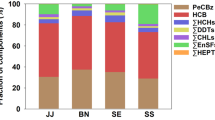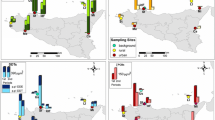Abstract
Most African countries have ratified the Stockholm Convention on persistent organic pollutants (POPs) and are expected to reduce emissions of POPs such as organochlorine pesticides (OCPs) to the atmosphere. Emerging evidence, however, suggests that there are contemporary sources of OCPs in African countries despite the global ban on these products. This study investigated the atmospheric contamination from OCPs in four West African countries—Togo, Benin, Nigeria, and Cameroon—to ascertain the emission levels of OCPs and the characteristic signatures of contamination. Polyurethane foam (PUF) disk passive air samplers (PAS) were deployed in each country for ca. 55 days in 2012 and analyzed for 25 OCPs. Hexachlorocyclohexanes (HCHs) and DDTs constituted the highest burden of atmospheric OCPs in the target countries, at average concentrations of 441 pg m−3 (range 23–2718) and 403 pg m−3 (range 91–1880), respectively. Mirex had the lowest concentration, ranged between 0.1 and 3.3 pg m−3. The concentration of OCPs in rainy season was higher than in dry season in Cameroon, and presupposed inputs from agriculture during the rainy season. The concentrations of ∑25 OCPs in each country were in the following order: Cameroon > Nigeria > Benin > Togo. There was significant evidence, based on chemical signatures of the contamination that DDT, aldrin, chlordane, and endosulfan were recently applied at certain sites in the respective countries.






Similar content being viewed by others
References
Adu-Kumi S, Kareš R, Literák J, Borůvková J, Yeboah PO, Carboo D, Akoto O, Darko G, Osae S, Klánová J (2012) Levels and seasonal variations of organochlorine pesticides in urban and rural background air of southern Ghana. Environ Sci Pollut Res 19(6):1963–1970
Aigner EJ, Leone AD, Falconer RL (1998) Concentrations and enantiomeric ratios of organochlorine pesticides in soils from the U.S. corn belt. Environ. Sci. Technol 32:1162–1168
Batterman SA, Chernyak SM, Gouden Y, Matooane M, Naidoo RN (2008) Organochlorine pesticides in ambient air in Durban, South Africa. Sci Total Environ 397:119–130
Bernstorff A, Stairs K (2000) POPs in Africa. Greenpeace Publication ISBN: 90–73361–66-4. http://archive.ban.org/library/AFROPOPs.PDF Accessed on June 14, 2016
Bozlaker A, Muszzinoglu A, Odabasi M (2009) Processes affecting the movement of organochlorine pesticides (OCPs) between soil and air in an industrial site in Turkey. Chemosphere 77:1168–1176
Dollimore L, Schimpf W (2013) Obsolete pesticide stocks—the past 25 years, lessons learned and observations for the future. Obsolete Pesticide Stocks. doi:10.1564/v24_dec_00
Fianko JR, Donkor A, Lowor ST, Yeboah PO (2011) Agrochemicals and the Ghanaian environment, a review. J Environ Prot 2:221–230
Garrison VH, Majewsk MS, Foreman TW, Genualdi SA, Mohammed A, Massey Simonich SL (2014) Persistent organic contaminants in Saharan dust air masses in West Africa, Cape Verde and the eastern Caribbean. Sci Total Environ:468–469 530–543
Harner T, Shoeib M, Diamond M, Stern G, Rosenberg B (2004) Using passive air samplers to assess urban-rural trends for persistent organic pollutants. 1. Polychlorinated biphenyls and organochlorine pesticides. Environ. Sci. Technol 38:4474–4483
Harner T, Pozo K, Gouin T, Macdonald A, Hung H, Cainey J, Peters A (2006) Global pilot study for persistent organic pollutants (POPs) using PUF disk passive air samplers. Environ Pollut 144:445–452
Hogarh JN, Seike N, Kobara Y, Masunaga S (2012) Atmospheric polychlorinated naphthalenes in Ghana. Environ. Sci. Technol 46:2600–2606
Hogarh JN, Seike N, Kobara Y, Ofosu-Budu GK, Carboo D, Masunaga S (2014) Atmospheric burden of organochlorine pesticides in Ghana. Chemosphere 102:1–5
ILO (1994) Chemicals in the Working Environment, World Labour Report, 1994, Geneva.
Jaward FM, Barber JL, Booij K, Jones KC (2004) Spatial distribution of atmospheric PAHs and PCNs along a north-South Atlantic transect. Environ Pollut 132:173–181
Karlsson H, Muir D, Teixiera C, Burniston D, Strachan W, Hecky R, Mwita J, Bootsma H, Grift N, Kidd K, Rosenberg B (2000) Persistent chlorinate pesticides in air, water, and precipitation from the Lake Malawi area, southern Africa. Environ. Sci. Technol 34:4490–4495
Klánová J, Čupr P, Holoubek I, Borůvková J, Přibylová P, Kareš R, Tomšej T, Ocelka T (2008) Monitoring of persistent organic pollutants in Africa. Part 1: passive air sampling across the continent in 2008. J Environ Monit 11(11):1952–1963
Manaca MN, Grimalt JO, Sunyer J, Guinovart C, Sacarlal J, Menendez C, Alonso PL, Dobaño C (2013) Population characteristics of young African women influencing prenatal exposure to DDT (Manhiça, Mozambique). Environ Sci Pollut Res 20(5):3472–3479
NPASP (Northern Presbyterian Agricultural Services and Partners), 2012, Ghana’s pesticide crisis, 2012. http://www.christianaid.org.uk/images/ghanas-pesticide-crisis.pdf. Accessed on June 29, 2013.
Pozo K, Harner T, Wania F, Muir D, Jones KC, Barrie LA (2006) Toward a global network for persistent organic pollutants in air: results from the GAPS study. Environ. Sci. Technol 40:4867–4873
Pozo K, Harner T, Lee SC, Wania F, Muir D, Jones KC (2009) Seasonally resolved concentrations of persistent organic pollutants in the global atmosphere from the first year of the GAPS study. Environ. Sci. Technol 43:796–803
Pozo K, Harner T, Lee CS, Sinha KR, Sengupta B, Loewen M, Geethalakshmi V, Kannan K, Volpi V (2011) Assessing seasonal and spatial trends of persistet organic pollutants (POPs) in Indian agricultural regions using PUF disk passive air samplers. Environ Pollut 159:646–653
Qiu X, Zhu T, Yao B, Hu J, Hu S (2005) Concentration of dicofol to the current DDT pollution in China. Environ. Sci. Technol 39:4385–4390
Shunthirasingham C, Mmereki BT, Masamba W, Oyiliagu CE, Lei YD, Wania F (2010) Fate of pesticides in the arid subtropics, Botswana, Souuthern Africa. Environ Sci Technol 44:8082–8088
Waber J, Halsall C, Muir D, Teixeira C, Small J, Solomon K, Hermanson M, Hung H, Bidleman T (2010) Endosulfan, a global pesticide: a review of its fate in the environment and occurrence in the Arctic. Sci Total Environ 408:2966–2984
Weber R, Aliyeva G, Vijgen J (2013) The need for an integrated approach to the global challenge of POPs management. Environ Sci Pollut Res 20(4):1901–1906
Weber R, Schlumpf M, Nakano T, Vijgen J (2015) The need for better management and control of POPs stockpiles. Environ Sci Pollut Res 22(19):14385–14390
Williamson S, Ball A, Pretty J (2008) Trends in pesticide use and drivers for safer pest management in four African countries. Crop Prot 27:1327–1334
WHO (2013) World Malaria Report 2013, http://www.who.int/malaria/publications/world_malaria_report_2013/report/en/ Accessed on June 29, 2014.
World Bank (2013) Obsolete pesticide stockpile: an unwanted legacy of the African landscape. http://www.worldbank.org/en/news/feature/2013/08/05/obsolete-pesticide-stockpiles-an-unwanted-legacy-of-the-african-landscape. Accessed on June 29, 2014.
Acknowledgments
We are very much grateful to all the people that helped us with air sampling in Togo, Benin, Nigeria, and Cameroon. This study was partly supported by the “Leadership Program in Sustainable Living with Environmental Risk” with the aid of the Strategic Funds for the Promotion of Science and Technology from the Ministry of Education, Culture, Sports, Science and Technology, Japan, and by internal research funds of Yokohama National University and the National Institute for Agro-Environmental Sciences.
Author information
Authors and Affiliations
Corresponding author
Additional information
Editorial Responsible: Constantini Samara
Electronic supplementary material
ESM 1
(XLSX 29 kb)
Rights and permissions
About this article
Cite this article
Isogai, N., Hogarh, J.N., Seike, N. et al. Atmospheric monitoring of organochlorine pesticides across some West African countries. Environ Sci Pollut Res 25, 31828–31835 (2018). https://doi.org/10.1007/s11356-016-7284-y
Received:
Accepted:
Published:
Issue Date:
DOI: https://doi.org/10.1007/s11356-016-7284-y




